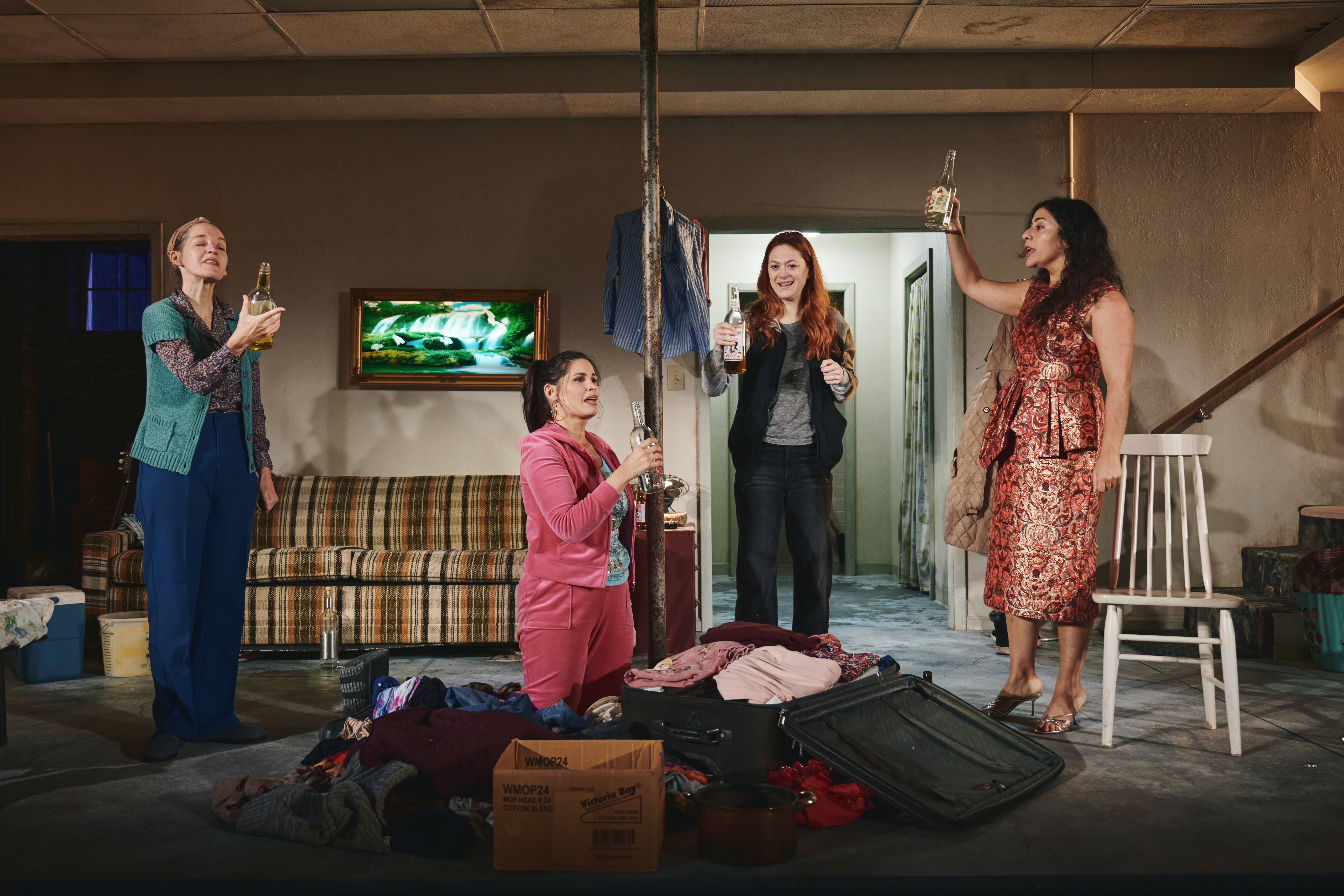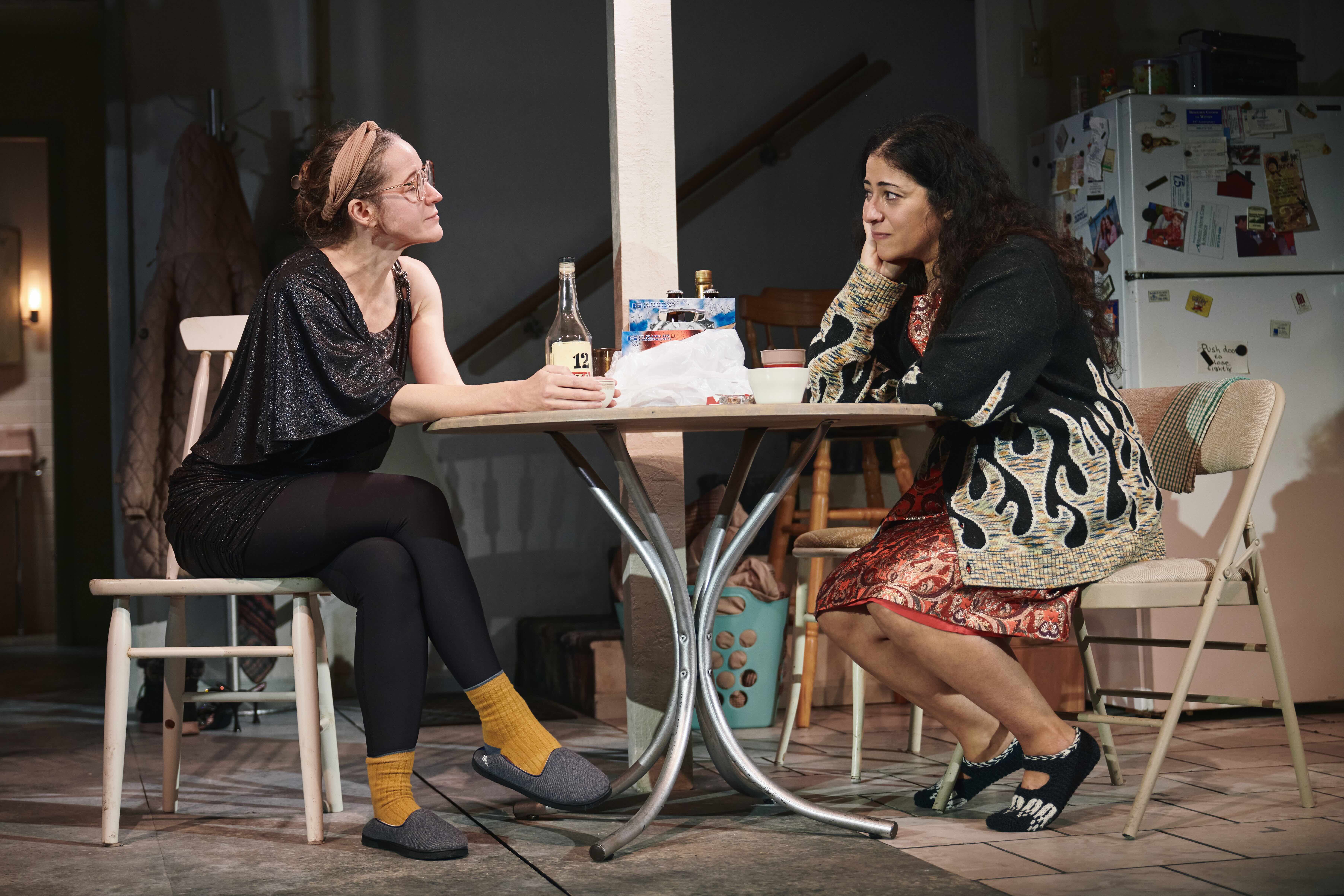
I’ve attended multiple writing workshops where the task assigned is to write something you believe would be impossible for the theatre: something you would never actually see onstage, without regard for the fact that you would never actually see it onstage. The results often fall to one extreme or another: actual violence, an actual birth, an actual entire Thanksgiving dinner, an actual war; a roller coaster, a five-hundred-person cast, a waterpark, a callout of stakeholders who are actually in the audience. Martyna Majok’s Queens achieves some of the seemingly impossible goals I’ve written down or heard shared in these workshops. Its cast speaks multiple languages onstage, and not just for a brief moment; the walls of Marsha Ginsberg’s set come apart at the hands of a ghost, a memory, a force of nature; some characters are featured for only one or two scenes, but they are still there, telling their stories.
Did anyone ever tell Majok that her work was impossible? Manhattan Theatre Club gave her the greenlight to present a work about an unscrupulous, almost unlikable (though understandable) woman, Renia (Marin Ireland), who claws her way up the ladder of American life with no regard for who she kicks off behind her. Renia loses so much that the only option left for her is to steal from others, and her uncompromising commitment to “own one entire building in America” turns her cold. Once, Pelagiya (Brooke Bloom) gave her a chance and Isabela (Nicole Villamil) gave her a shoulder to cry on, but she repays them with betrayal. In some plays, Renia would be the villain, the morally-vacant landlord inflicting her will on unsuspecting immigrant women trying to make enough money to send back home. In Majok’s hands, we aren’t granted the simplicity of a one-dimensional antagonist, but must grapple instead with the choices we would make were we in Renia’s place.

The possibility of impossibility has clearly not deterred Majok from marching forward into a theatre industry whose parameters seem to shift with every news alert. She’s a Pulitzer Prize winner, but the honor is not a ticket to future material success in the ever-changing, oft-shrinking theatre landscape. 3Views readers do not need a reminder of the loss of physical space, funding, and emerging talent that has rattled our industry due to the pandemic, conservative governments, and rising costs of living (if you’ll allow me a pun). Plenty of talented, award-winning artists have changed careers or focused on higher-earning projects, such as television, to make a living. Majok (who, like most working playwrights, also works in film and television) presents with Queens a work that many producers, casting directors, even literary managers may classify as impossible theatre. It is a work full of women and only women, of women speaking Polish and Dari, of women learning the nuances between a Ukrainian accent and a Belarusian one, with the help of dialect coach Jane Guyer Fujita (I cannot speak to the authenticity of these nuances onstage, but no one sounded cartoonish). It is a work for eight actors with no doubling and is, therefore, expensive. Since 2020, two-handers have prevailed, first for their relative safety–keeping two actors from getting sick is a lot easier than keeping a twenty-person musical from getting sick–but also for their comparative costs. Fewer bodies, fewer costumes, fewer paychecks.
I do not mean to invalidate the many two-handers that have triumphed in the last five years (that one wasn’t intentional). If a playwright feels compelled to tell a story with two characters, so be it; if that means they have a higher chance of being produced, of getting paid, more power to them. But writing just to be produced or to fit a trend is stifling, even as it is necessary; your next work, the passion project with fifty characters and a trapeze artist, can’t get produced if no one knows who you are. To make a living as an artist is to inhabit this dual reality and to face these creative frustrations head-on, pen in hand.
Of course, much of Majok’s oeuvre may have been deemed impossible by producers for years. Her plays about the immigrant experience sit in that sweet spot of resonating with American audiences but not being quite joyful or fluffy enough to attract the prototypical (white, older) season-ticket holder (or at least this is often the assumption of those at the helm of season planning). Majok unapologetically writes what she knows while also exploring what she doesn’t: much of her work is inspired by her own immigration story, but in Queens and other plays, immigrants from multiple other nations coalesce to pursue their fleeting American dreams.

Life imitates art in ways good and bad. The morning after I saw Queens, in which Pelagiya and Aamani (Nadine Malouf) hope that their overcrowded basement apartment won’t succumb to an electrical fire, I woke to the news that two people had died when their basements flooded in a torrential New York downpour. The next week, an immigrant New Yorker was elected mayor. Representation isn’t liberation, but in a moment when anyone who looks, speaks, prays, or dresses not American enough is at risk of federally-directed, often public violence, it does feel like a victory. A City Hall victory may be more equipped to keep vulnerable people out of overcrowded basements, but without stories like Queens onstage, some New York theatre-goers wouldn’t even know that this is indeed a city-wide problem. Majok isn’t exclusively trying to make activist art, and the classification of all stories outside the mainstream American experience as activist art is patronizing, but art still teaches and changes people at its core. That is a good and powerful phenomenon, one that is typically better served by those plays outside our prototypical season-ticket holder’s expectations.
There will always be impossible elements of theatre destined to remain on the page, not the stage. Let those be airplanes and toddlers and tigers, not the stories of our city. Let the next playwright be free of the expectations for tidiness, small casts, and linear storytelling. Let her write what she wants.
--
Queens is produced by Manhattan Theatre Club and plays at New York City Center Stage I through December 7.

